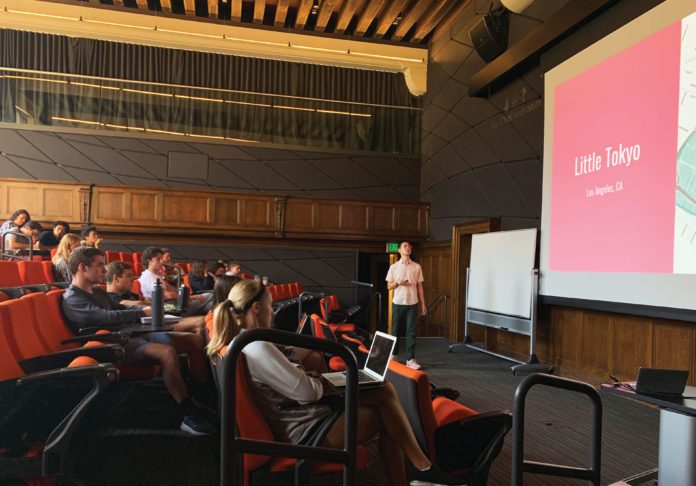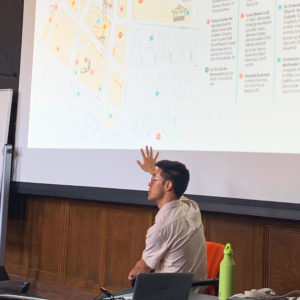
Jonathan Jae-an Crisman, assistant professor of Public & Applied Humanities at the University of Arizona, spoke about the historical progression of cultural gentrification and the various protesting and congregating activities in the downtown ethnic enclave of Little Tokyo at “Protecting Ibasho,” a Sept.17 talk in Choi Auditorium. The audience included students of art professor William Davis’ History of Urban Design class.
During the talk, Crisman approached the cultural history of Little Tokyo chronologically, dividing its historical timeline into four distinct yet connected “waves.” Each represented different periods of gentrification and corresponding civic expression. Davis said the first wave started in the 1930s and had to do with building community identity and social relations. The second wave started in the 60s and 70s and was political activist-oriented. The third wave happened in the 80s-90s and was about institution and infrastructural building, and the current period from 2000 onward contains a range of community-organizing activities related to gentrification.
When introducing the four waves of civic expression, Crisman showed a series of historic photographs such as the first Nisei Festival on the First Avenue, the anti-war protests, and the art exhibitions that convene community members. About 40-50 students attended, and after the talk, some students asked Crisman how to be involved in these civic expression activities.
Davis said he reached out to Crisman to set up this talk because he thought it would be useful for the students to learn about first-hand research. The talk not only fits into the class’ unique organization of examining one city a week, but also aims to challenge some of the existing stereotypes surrounding LA as a city, according to Crisman.
“The week when I gave my talk was during the Los Angeles week. Within urban studies, there’s a pretty widely accepted urban history for LA that has to do with land speculation and transportation development,” Davis said. “I think that history is true, but there’s actually many more histories in LA in terms of how different communities develop, especially how different ethnic and immigrant communities develop, and those histories are left out from the dominant history.”
Hailey Gil (senior), an Urban Environmental & Policy (UEP) major who is in Davis’ class and attended the talk, said Crisman’s talk is important because it differentiates two similar concepts of cultural and economic gentrification.
“When we’re talking about gentrification, you can talk about cultural gentrification and establishing a sense of community in a place, and there’s also economic gentrification, and [that is about] whether or not somebody can afford to live there,” Gil said.

Crisman has also done gentrification research on other regions, such as Leimart Park in South LA, Boyle Heights to the east and Chinatown, which is another major ethnic enclave adjacent to Little Tokyo. Crisman said the challenges of gentrification faced by residents in these regions are “similar and different” due to their varied history of development.
“Each of these different neighborhoods has a particular set of stakeholders. There are different histories in terms of when people arrived in the U.S. and what kind of political power they’ve been able to build. For example, [in] Little Tokyo, now it’s [a] fourth-generation community whereas Chinatown actually has a lot of first-generation people,” Crisman said. “Those folks are actually facing more intense challenges because they also have to grapple with communicating in a political system where English is dominant, and having to grapple with financial instability.”
Professor of sociology Jan Lin has also done gentrification research but is more focused on economic gentrification in northeast LA. Lin said the term “gentrification” often carries a negative connotation, but sometimes people forget the word means not only displacement, but also upgrading.
“The intellectuals and the public media are much more concerned with the aspect of displacement,” Lin said. “But I think it’s quite possible for proponents of gentrification to place more emphasis on the improvement of business and the rise in property values, and they might claim it to be an inevitable process.”
Davis adds that there is a general lack of nuanced understanding on the term “gentrification,” as it encompasses aspects from multiple levels of society.
“Gentrification is a tricky term. It’s kind of a steamroller word, it will just flatten any argument. It’s a very complex thing to understand,” Davis said. “Of course it’s economic, it’s cultural, but there’s enormous numbers of forces at play, from a policy level, from a cultural side too. It’s important to see the details.”
LA Metro is constructing a regional connector in Little Tokyo to allow passengers to transfer from Gold Line to other lines without passing through Union Station. Crisman said the future of Little Tokyo would involve a new wave of civic expression centered around the building of this connector and the possible gentrification it could entail.
“I think we’re seeing this new wave of civic expression right now in response to the Metro projects. They’re aware of the worst possible outcome, which is Little Tokyo being erased off the map,” Crisman said. “They’re aware of what needs to be done in order to hold on to their place in the city.”
![]()


































